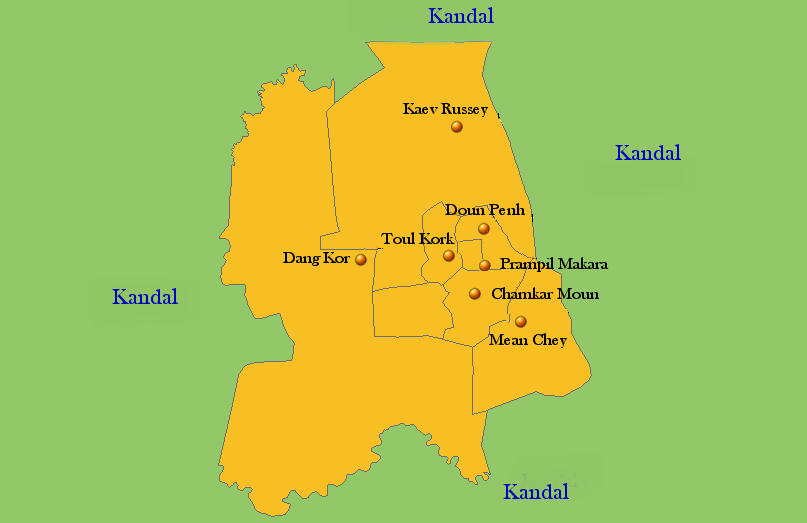Phnom Penh
Phnom Penh evokes the exotic.
Phnom means "Hill" and "Penh" the name of the honourable lady: the Hill of Penh.
Phnom Penh has charm, benefits from wide avenues to three or four lanes, located to the immensity of the four arms of the rivers formed by the Tonlé Sap and the Bassac and the wide Mekong (top and bottom). This place is known as the Chatomukh, "four faces" Cambodians Recalling the four faces of Angkor Thom, also called "Four arm".
Traffic is chaotic. He must stay zen and adapt in the conduct to the khmer: never stop, but always move, forward, exceed. In Phnom Penh, the day it roll slowly, never swearing but horns blows.
It is also the opportunity to discover the moto-crew for small displacements.
Phnom Penh becomes Capiltale
Since the first taking of Angkor by the Thais, in 1352, the Khmer Court moved from site to site, each new King was required to build a new capital.
In 1432, the King stepped down Angkor just be vandalized by the Siamese for a second invasion.
The King abandoned Angkor and installs his capital at Longvek (located between Phnom Penh and to the South of the Tonlé Sap).
In 1594, Longvek is taken and devastated. According to legend, the Siamese formed parts of money in the walls of bamboo protecting the city. Soldiers reportedly destroyed them to retrieve the loot, thereby depriving of protection.
In 1618, King Chey-Chetha II married a Vietnamese Princess and established the capital at Oudong (North of Phnom Penh) for a long period. Then Pursat was the abandonment.
Until 1830, Pursat (between Battambang and Kompong Chhnang) becomes the temporary capital for the Khmer Kings, when they were hunted by a plot or attack their enemies.
In 1863, the young King Ang Voddey, becomes Norodom signed a Treaty of protectorate and the Government of Napoleon III, selects, and moved to Phnom Penh which became the capital of Cambodia until today.
The true extension of Phnom Penh intervened until the independence of Cambodia in 1953
Drive in Phnom Penh
The Royal Palace and silver Pagodge: built in 1866 by King Norodom, on Tonle Chatomouk of Phnom Penh and then called Preah Reach Vang Chatomuk Mongkut Borane. Its official inauguration took place on February 14, 1870.
Buildings whose structure is inspired by Khmer sculpture, are oriented to the East, sacred construction rules. These works were carried out by French and Khmer architects.
In the early 20th century it housed the Royal dance troupe and the Royal elephants. The whole is composed of several buildings, including the throne room and a Pavilion for the représentaitons arts.
Official Récidence of the King, it is partly closed to the public.Visitors have access only to its surroundings and the pagoda of money (or wat Preah Keo), constituted over 5000 slabs of silver (weighing 1 Kg/slab).
The National Fine Arts Museum: is a nice building traditional sandstone red, located north of the royal palace, recently restored national museum, one of the jewels of architecture phnompenhoise.
The museum includes 4 halls, houses more than 5,000 works of art dating from the 5th to the 13th century, of which most beautiful sculptures Khmeres in the world, costumes of ceremony of the 19th century, pottery, bronzes of pré-Angkoriennes periods, the collection of Buddha Angkorian post, with splendid Royal pageantry and the palanquins boats.
Visitors seeking relaxation can take a break in the patio central, with a basin to lotus, while admiring the gems of one of the richest civilizations of Asia.
The Phnom Wat:
is perched on a small hill of 27 m in the capital.
It is a place of drive busy day, while remaining open at night. Many small itinerant traders are located down the Hill. People come to Wat Phnom a vow to pray for success in business or make a ride.
Wat Phnom is also famous for the large population of monkeys there have elected domicile. On the other hand, the only elephant in Phnom Penh is working at the foot of the Wat Phnom, walking tourists on his back for a tour of the Hill.
Markets
The best known is the market Central ("Psar Thmey"), which was built in the year 30.
Other markets: Olympic Tum Pong, O russei market Tuol,...
Sisowath Quay: beautiful promenade on the Tonle Sap River, that roving of sells





